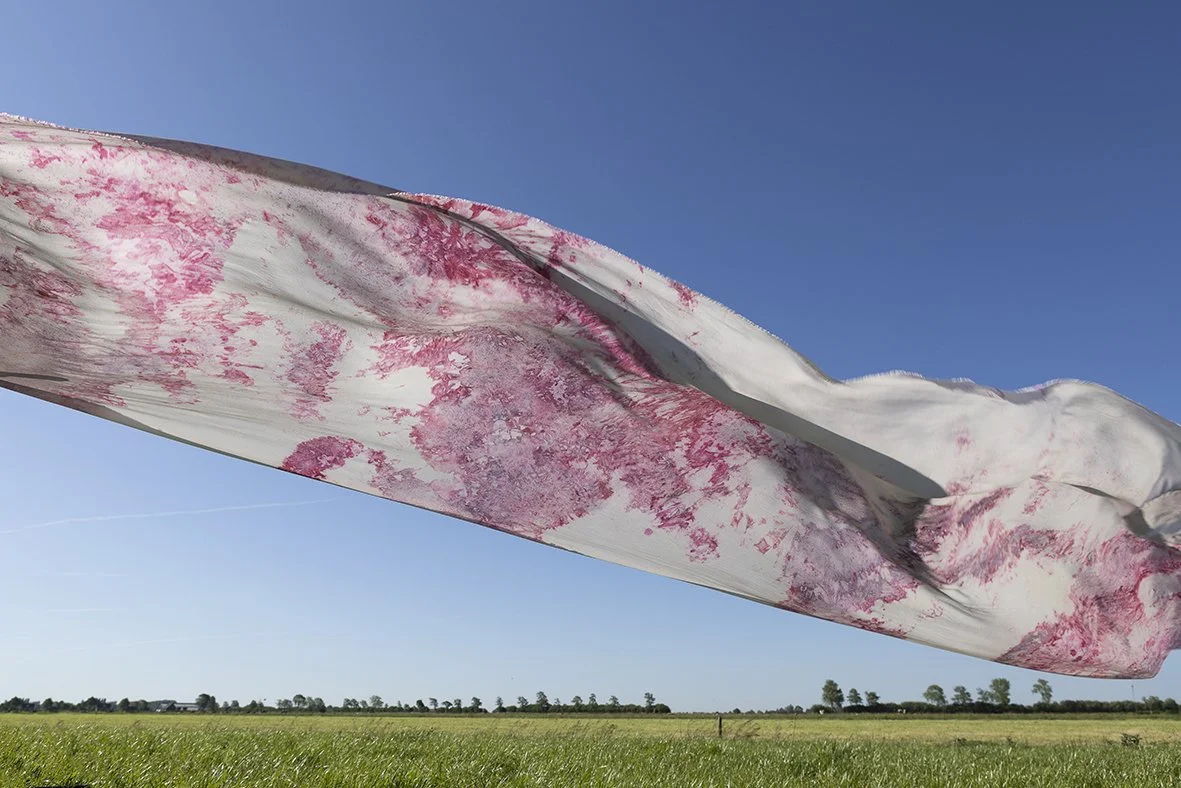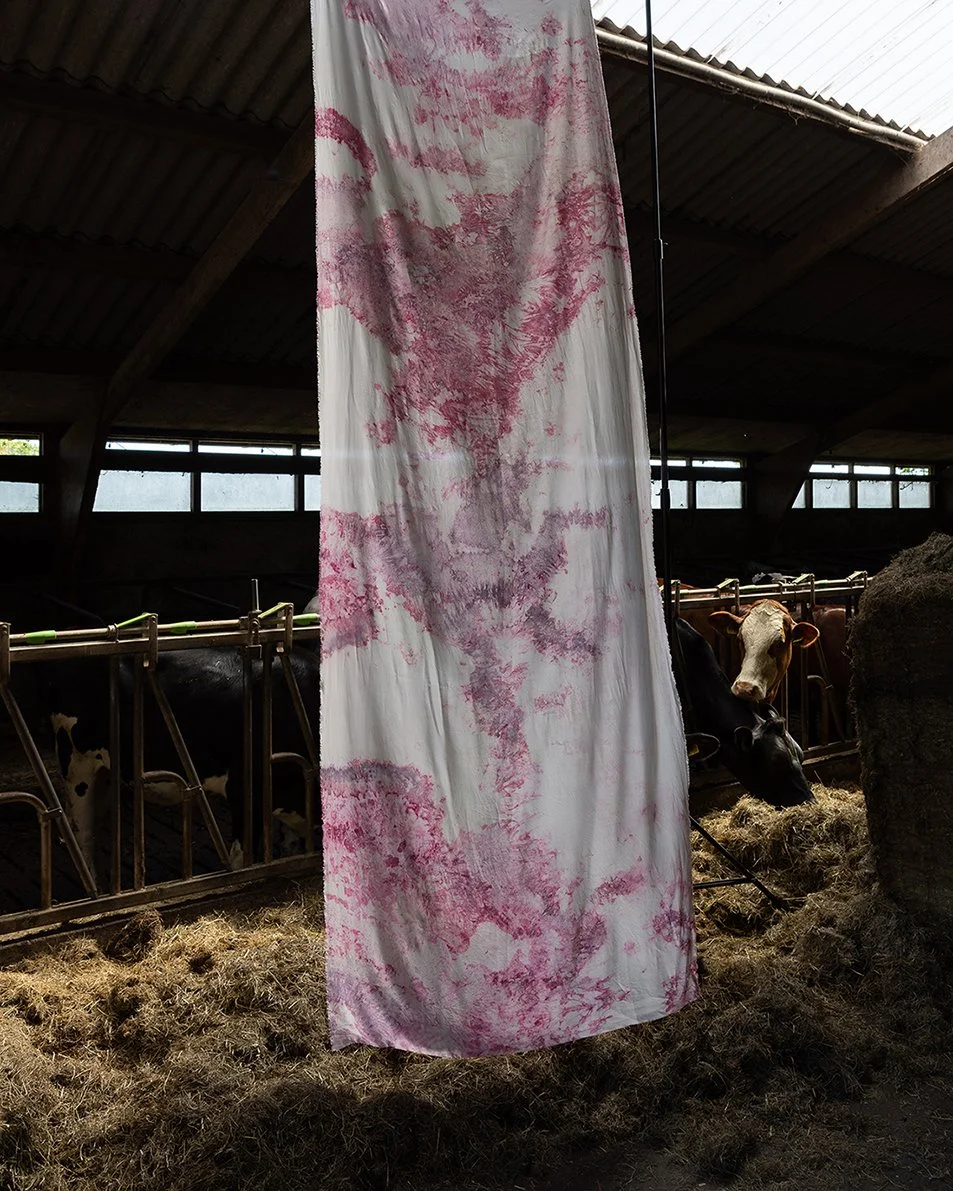Colour Grown from the Land
At Veenweide Atelier, Faber Futures grows colour with bacteria, using farm waste and residual heat to cultivate local pigments.
A Highlight of Dutch Design Week 2025
In the northern Netherlands, the province of Friesland is characterized by its open fields, slow waterways, and expansive skies. However, beneath this serene landscape lies a delicate foundation of peat—a dark, fertile soil that has formed over thousands of years through the interplay of water and plant life. These peatlands have long supported farming and rural communities, but they are also among the country's most vulnerable landscapes.
As the climate warms, the balance between land and water is deteriorating. Decades of draining the soil for agriculture have caused it to sink and dry out, resulting in the release of significant amounts of CO₂ into the atmosphere. For generations, this practice maintained productive meadows and supported farms, but it has also initiated a slow collapse. The fields that once nourished communities are now more complex to manage, and the species that thrived in these wet meadows—such as plants, birds, and insects—are disappearing.
In response to this changing landscape, the Veenweide Atelier (Peat Meadow Atelier) provides a space for experimentation and dialogue. Led by artist and eco-social designer Henriëtte Waal, in collaboration with the Arcadia Foundation, the project serves as an ecosocial design laboratory where farmers, residents, scientists, and designers come together to rethink how life in the peat meadow region can continue in a changing climate. Rather than viewing the land solely as a resource, the atelier encourages participants to recognize it as a living system—one that requires collaboration, care, and imagination.
The atelier’s approach is grounded in practice. Participants engage directly in the field, where the impacts of climate change are most apparent. By combining local knowledge with scientific research, they explore practical ways to keep peat soils wet, restore biodiversity, and reduce emissions—all while supporting the livelihoods that depend on these ecosystems. This creates a careful balance between caring for the land and reimagining its use.
One of the experiments featured during Dutch Design Week demonstrates how such cross-disciplinary collaborations can pave new pathways for sustainable production. In partnership with the London-based studio Faber Futures, the Veenweide Atelier investigates the potential of microorganisms to create natural pigments for textile dyeing.
Together with Frisian farmers, microbiologists, and textile makers, Faber Futures works with pigment-producing bacteria that thrive in healthy soil and manure. These living organisms can generate a wide range of colors, providing an ecological alternative to synthetic dyes.
The team experiments with locally cultivated bacterial strains, testing how agricultural waste can nourish these microbes while utilizing residual farm heat to support their growth. The result is a fit-to-farm model of biomanufacturing—an interconnected, locally rooted system that links design, biology, and agriculture.
The outcome is a large printed fabric that embodies the collaboration between humans, plants, and bacteria. It serves as both a scientific exploration and a symbolic gesture, pointing to a future where color is grown rather than extracted, and where the smallest forms of life can help reshape how we produce and engage with materials.
The Veenweide Atelier reminds us that design can transcend aesthetics or innovation; it can be a form of stewardship. In a landscape where the effects of climate change are evident, it inspires us to view design as a way to listen, adapt, and rebuild connections between people and the environments that sustain them.
Bacterial-dyed textile at the Veenweide Atelier | Textile and pigments: Faber Futures | Photo: Tryntsje Nauta
Project Credits
Ecosystem Initiator & Implementation Partner
Henriëtte Waal – Artistic Director, Veenweide Atelier
Designer & Technologist
Faber Futures
Project Commissioner
Arcadia Foundation
Collaborators
Soil-dwelling microorganisms
Jeroen Siebring – Microbiologist, Knowledge Centre of Expertise for Biobased Economy, Hanze University of Applied Sciences
Kees Boon – Organic Dairy Farmer, Boon Family Farm
Simone Larabi – Partner, Material Researcher and Product Designer, House of Design
Tess van Zalinge – Fashion Designer
Willem Bruinsma – Organic Flax Farmer, Bruinsma Farm
Photography
Tryntsje Nauta, Brecht Duijf and Faber Futures
Resources
Dutch Design Week 2025 – Fit-to-Farm Models for Biomanufacturing
https://ddw.nl/programme/fit-to-farm-models-for-biomanufacturingFaber Futures – Prototyping Fit-to-Farm Models for Biomanufacturing, Friesland
https://faberfutures.com/projects/prototyping-fit-to-farm-models-for-biomanufacturing-friesland/Arcadia Foundation – Veenweide Atelier: A Nature Laboratory for Eco-social Design
https://arcadia.frl/en/projecten/veenweideatelier/Fries Museum – Veenweide Atelier: Designs for a Sunken Peatland
https://www.friesmuseum.nl/en/see-and-do/exhibitions/veenweide-atelier/Faber Futures – Studio Archive and Biodesign Projects
https://faberfutures.com/projects/Dutch Design Daily – Veenweide Atelier: Design for a Sunken Marshland
https://dutchdesigndaily.com/stories/veenweide-atelier-design-for-a-sunken-marsh/
DDW25 Location
Klokgebouw
Klokgebouw 50
5617 AB
Words
Nina Zulian



